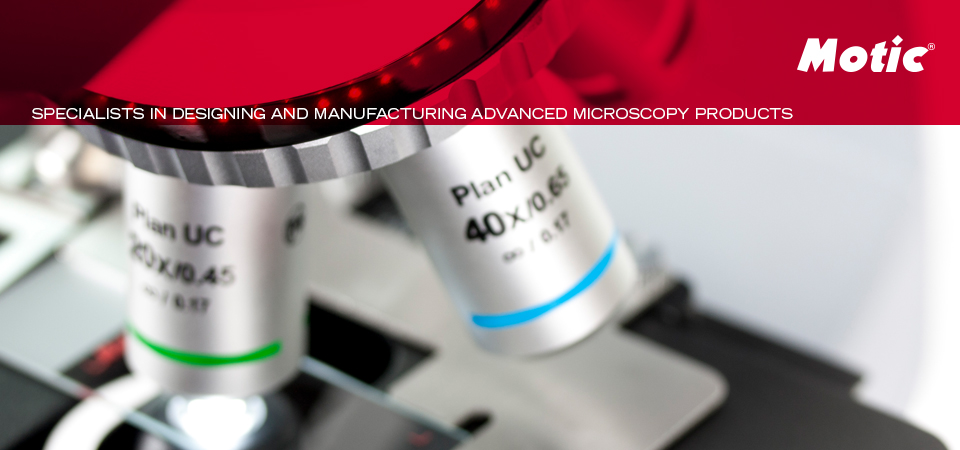Crystal structure of Phenyl-2-hydroxybenzoate or phenyl salicylate, or salol, is presented here by using polarization microscopy. It is a chemical substance, introduced in 1886 by Marceli Nencki of Basel. It can be created by heating salicylic acid with phenol. It appears in the form of small white crystals or crystalline powder with pleasant aromatic odour and taste.
Once used in sunscreens, phenyl salicylate is now used in the manufacture of some polymers, lacquers, adhesives, waxes and polishes. It has been used as an antiseptic based on the antibacterial activity upon hydrolysis in the small intestine. It acts as a mild analgesic.
Tuesday 29 April 2014
Good news: Fluorescence is now safer and easier to handle
Any traditional Fluorescence user is aware of the alignment procedure to get the brightest possible image; every lab assistant knows about difficulties in case the mercury bulb has to be replaced again because of a quite short life time.
Nice to hear that Motic offers a solution: For the Elite versions of BA upright biological microscopes, a selection of Epi-LED modules, to be placed between microscope body and eyepiece tube, is available for an easy-to handle Fluorescence. Now this contrast method is ready to be introduced in safety-sensible environments like medical schools, where the teaching program each year creates a new generation of young but unexperienced professionals. No alignment of the illumination, no warm-up period, no heat development obstructs an immediate start of work: Best preconditions for an uncomplicated workflow and safe teaching.
The Epi-LED modules come in a selection of 3 different units, each of them a combination of an LED light source and a well-adapted dichroic/barrier filter combination. At the moment 3 different setups can be supplied:
These modules cover AURAMINE 0 applications like Malaria/Tuberculosis detection as well as standard FITC stainings.
At first instance this is a good message for everyone who know about traditional HBO light sources: alignment difficulties, short life time, heat development, need for an environmental-friendly disposal. All these facts in mind, you will agree that LEDs will be the future of specific microscope illumination demands. Further handy solutions can be expected.
If you want to know more, take a look to this catalogue.
Nice to hear that Motic offers a solution: For the Elite versions of BA upright biological microscopes, a selection of Epi-LED modules, to be placed between microscope body and eyepiece tube, is available for an easy-to handle Fluorescence. Now this contrast method is ready to be introduced in safety-sensible environments like medical schools, where the teaching program each year creates a new generation of young but unexperienced professionals. No alignment of the illumination, no warm-up period, no heat development obstructs an immediate start of work: Best preconditions for an uncomplicated workflow and safe teaching.
The Epi-LED modules come in a selection of 3 different units, each of them a combination of an LED light source and a well-adapted dichroic/barrier filter combination. At the moment 3 different setups can be supplied:
- 455nm LED with a long pass barrier of 485nm
- 470nm LED with a band-pass barrier of 535/40nm
- 470nm LED with a long-pass barrier of 515nm
These modules cover AURAMINE 0 applications like Malaria/Tuberculosis detection as well as standard FITC stainings.
At first instance this is a good message for everyone who know about traditional HBO light sources: alignment difficulties, short life time, heat development, need for an environmental-friendly disposal. All these facts in mind, you will agree that LEDs will be the future of specific microscope illumination demands. Further handy solutions can be expected.
If you want to know more, take a look to this catalogue.
Wednesday 16 April 2014
Small creatures of great importance
Fruit flies, Drosophila, are small insects that, as their name implies, often are found in and feed on fruits, although they like other foods, too. They prefer to eat matter that is decaying or fermenting, and most varieties are fairly tiny. They are found around the globe and reproduce extremely quickly, which has given them a significant role in research despite their reputation as a nuisance. Many varieties get into buildings simply by finding small cracks and holes to slip through, but they also get transported from place to place in less-than-ideal produce. People typically can get them under control by keeping homes free of rotting items and by using homemade or purchased traps.
One of the ways to distinguish between fruit fly males and females is to look at the color of the abdomen. A fly's abdomen is made up of many different segments. On a male fly, the last two segments of the abdomen are much darker than the female. The male fruit flies have thick black bands, whereas the females tend to have one darker band on the bottom with a lighter band on top of that.
One of the ways to distinguish between fruit fly males and females is to look at the color of the abdomen. A fly's abdomen is made up of many different segments. On a male fly, the last two segments of the abdomen are much darker than the female. The male fruit flies have thick black bands, whereas the females tend to have one darker band on the bottom with a lighter band on top of that.
Subscribe to:
Posts (Atom)









